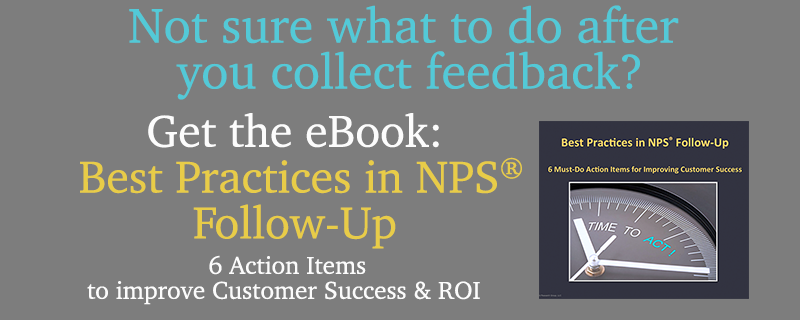Search Waypoint Resources
3 Steps to Feedback Analysis That Drive Action in B2B
This post was originally written for Shep Hyken’s Customer Service blog.
In “real life” if you have 1 happy customer and 1 unhappy customer, do you average them together to end up with a single “neutral” customer?
Most people would answer, “No.” Yet this sort of feedback analysis happens all the time. And then companies wonder why they are never able to “move the needle.”
Let’s take a step back. Since we know that happy and successful customers are more likely to renew, buy more, and tell refer friends and colleagues, most companies run customer satisfaction surveys. It’s critical to understand not only the percentage of customers that are “happy” but to also know why or why not. This takes some careful planning and organization to collect data that drives action.
Armed with effective analysis and a powerful financial story, you can use voice of customer insight to truly accelerate growth for the company.
If want to elevate your value to the business then here are the 3 steps to pull that story together.
1. Ensure your analysis of feedback data is organized the same way the company goes to market. NEVER analyze in the aggregate. Companies don’t sell in the aggregate, they don’t market in the aggregate, and they don’t build products in the aggregate.

Does your analysis combine apples + oranges to create these fictitious Orples?
For example, most companies treat their top “strategic” customers (especially in B2B) very differently than smaller accounts. Therefore the experiences that “Tier 1” customers have is quite different than the rest, and so their needs, expectations, and results will be different.
If your company goes-to-market regionally, across different product lines and markets, and via different customer segments then ensure your analysis follows this model. Combining feedback results from all customers in one bucket is a kin to creating a strange hybrid fruit known as an Orple. I wonder what that would taste like…but I digress.
2. Critically important for B2B organizations: recognize that there really isn’t a “customer.” Instead, there are groups of people inside a company that collectively make decisions to buy from your firm. Those people come from different perspectives and also have different expectations. For example, an “end user” of your products and services” probably wants it to be easy to use, while the person who holds the budget (a “decision maker”) needs to realize (perceive) genuine value. And just like our orple fruit in step one, combining feedback results from different organizational roles only obfuscates the results.
If you don’t think you have “role” information for your customers, I guarantee that someone – probably the account team – knows who the people are inside the account that really make the buying decisions. Those are the most critical people from which to acquire feedback and act on what they are telling you. By engaging your account teams to help define the list, 2 critical outcomes will result:
- Your account teams will be “bought in” to helping with follow-up. You’ll be acquiring feedback from the people that matter to them, and you’ll be able to provide them with account-level insight that will help them better improve relationships through tighter focus.
- Your contact list will be from the people that matter most, and therefore will truly represent buying cycles. You’ll also be able to get that contact role data for your aggregate analysis
Of course, you could also ask the customer in your feedback questionnaire, but be careful how you position that with contacts you should already “know.” Remember that “surveys” are a touchpoint, and any bad experience can erode customer relationships.
3. Now that you can perform proper analysis on your feedback data, make sure that you are telling a financial story wherever possible. Business leaders don’t want to hear about statistics, they want to hear about money. Stop score watching and instead focus on driving legitimate improvement by isolating the variables per items 1 and 2, and then tying the data to financials.
Consider these examples – which is more likely to get a CEO’s attention?
- “Our Net Promoter Score (NPS) is +22 overall, a 5 point drop form last year… we better do something.” CEO replies, “Is that 5-point drop statistically significant?” Uh oh… now you’re taking away precious executive time defending your analysis, and not driving action (i.e. results!).
Alternatively, consider this example:
- “We received feedback from 82% of our total revenue. Our strategic accounts, which are 72% of our revenue overall, are represented well within the respondents. Our analysis shows that 13% (or $23M) of our Annual Recurring Revenue is at risk (from low-scoring and silent accounts, which are generally far more likely to churn). We also find that there is an up-sell potential with 17% of our strategic accounts (accounts that love us and spending less than peer accounts), which amounts to $28M. There are several areas that are causing this churn. Shall we go into discussing those areas?”
If you can’t tell a story like this then you’re likely wasting time presenting data to leadership, which is unlikely to “move the needle.” If you want to increase your own personal value, invest in doing things that will accelerate growth by giving people decision-ready evidence. And if you don’t have, go get it. Partner with your Sales team to get the right contact list and drive responses from everyone that interacts with your company. And partner with your Finance organization to get appropriate revenue data (such as MRR or CLV) so you can tie the feedback with financials. You’ll need those partnerships anyway to drive the right change after the fact, so might as well enlist them up front to be a part of the solution.
With these three steps, feedback can be a powerful leading indicator that accelerates growth. Unfortunately, most companies fail to produce this analysis and end up doing more of the same instead of striving for improvement. Which story are you telling…?
